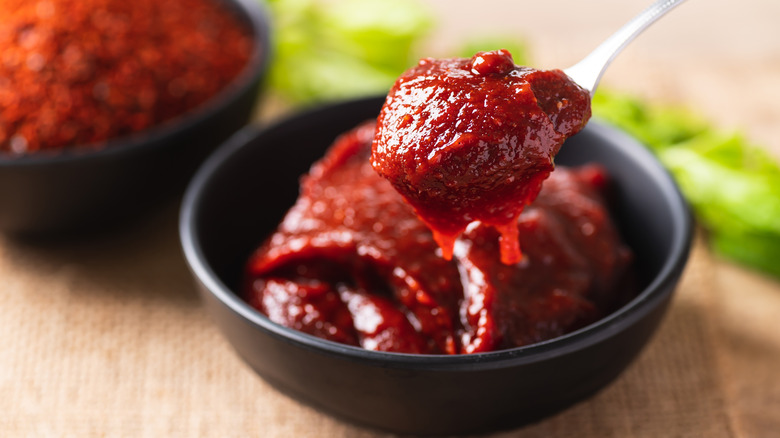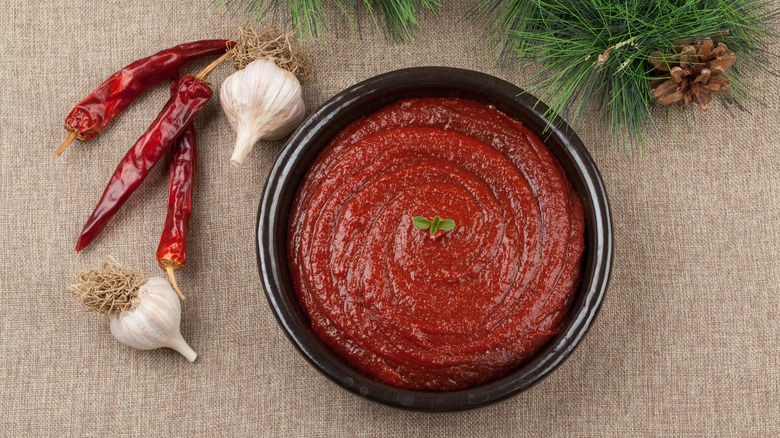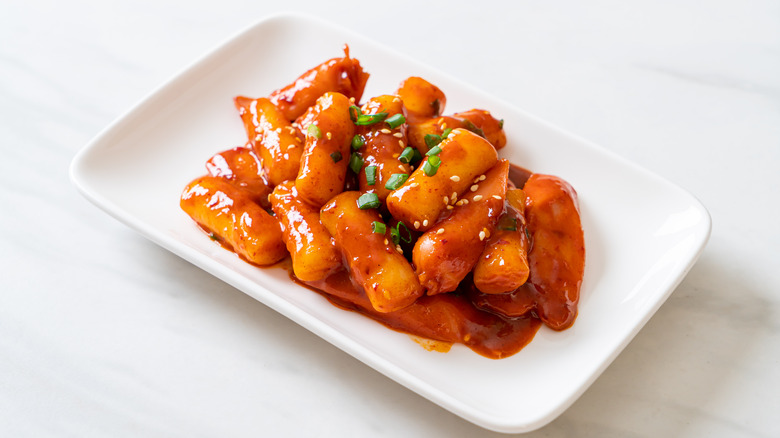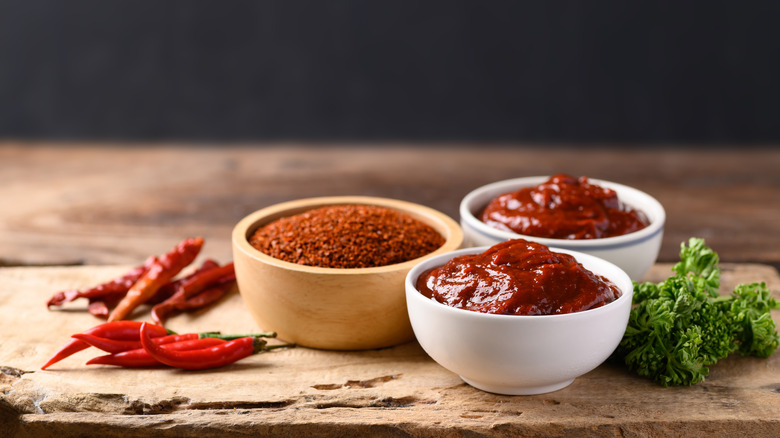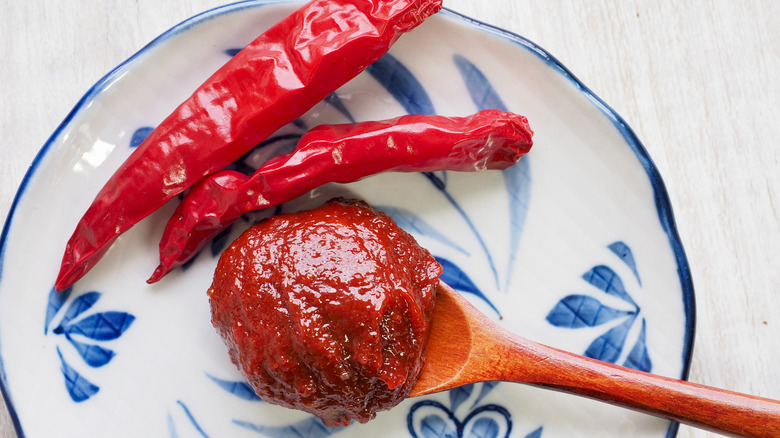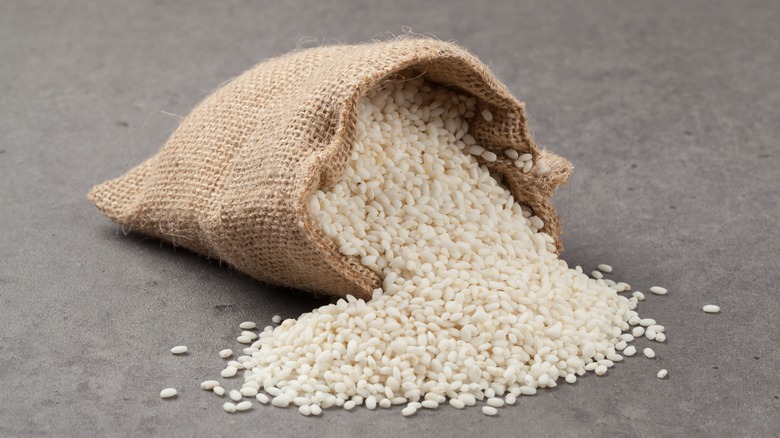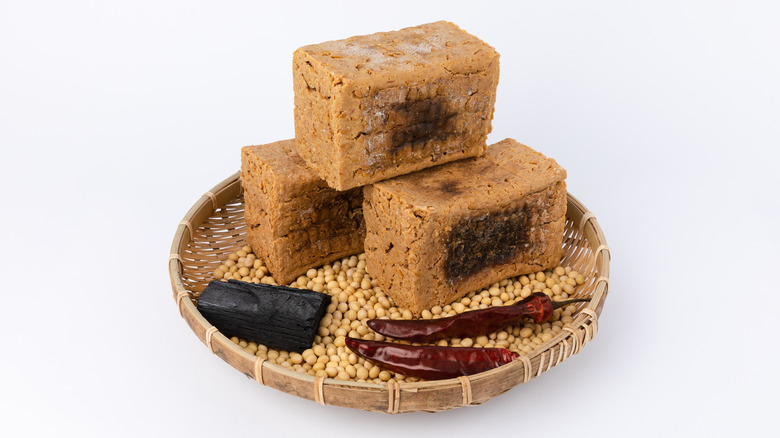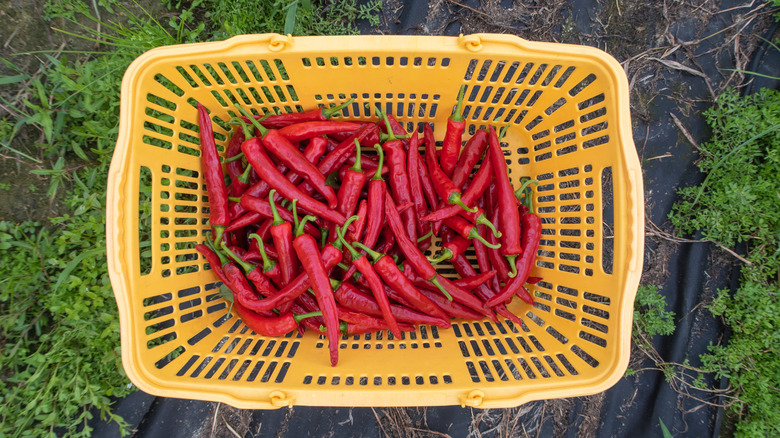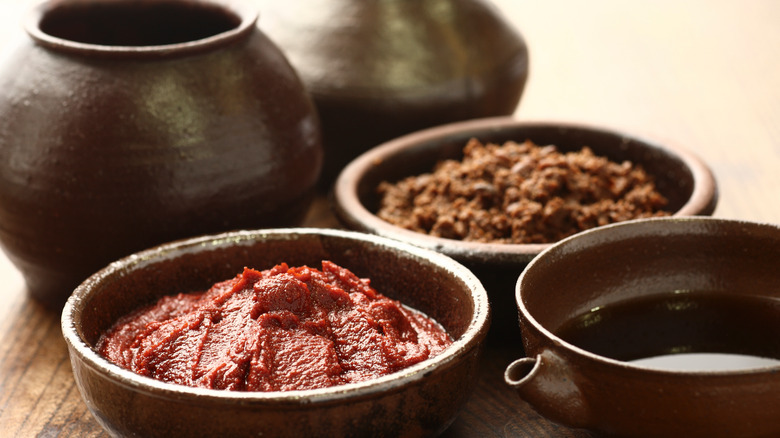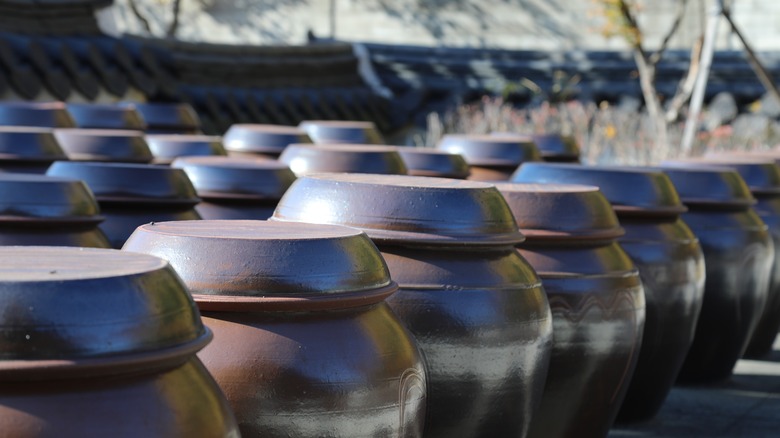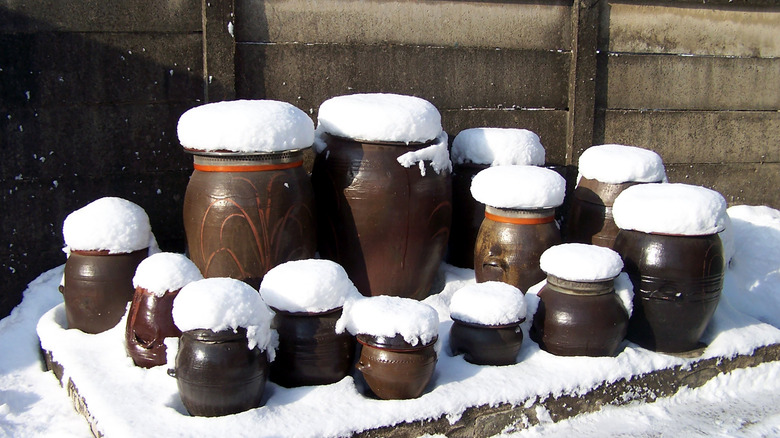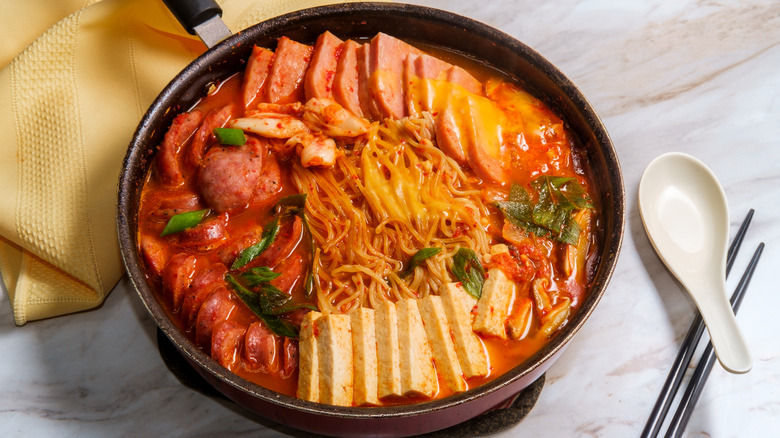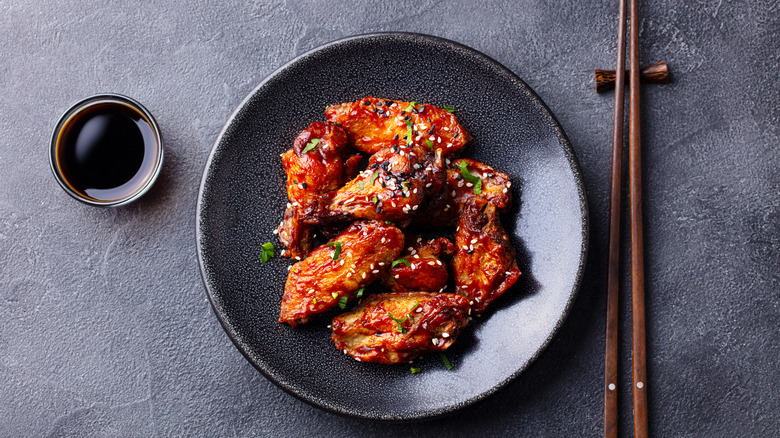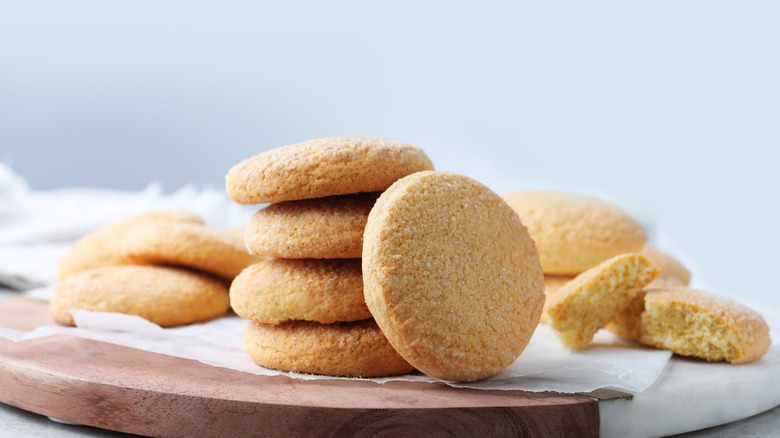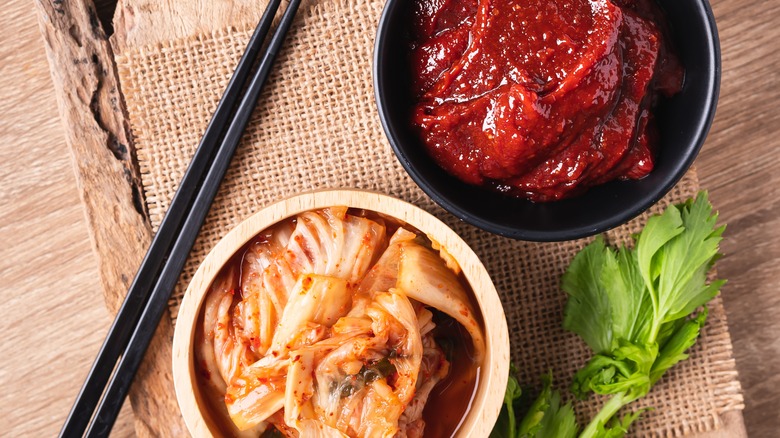14 Facts You Should Know About Gochujang
Gochujang is one of the many things that make Korean food so delicious. But what else about this chili paste makes it scrumptious and worth putting in everything?
First off, gochujang has an absolutely stunning color. It ranges from a bright red to a dark, almost rusty maroon color, depending on the chilies that are used. Other than chiles — specifically gochu chiles — gochujang is made from sticky rice, meju (fermented soybean flour), and barley malt. These ingredients are blended together into a paste and then left to ferment for months, and sometimes years, until the gochujang has matured and become sticky, spicy, and absolutely delicious.
You may be a gochujang expert or have never heard of it before, but wherever you land on the gochujang spectrum, be prepared to learn something new with this information that we dug up. It will be sure to tickle your taste buds and leave you hungry for more knowledge (and, of course, gochujang).
1. There is a gochujang village in South Korea
If you have ever had Korean food, you will know it comes with many regional variations and many flavors that blow your mind. In fact, you could say that many Korean dishes take you on a flavor journey, all the way to Flavortown. Gochujang is one of the essential Korean condiments you can thank for the irresistibility of Korean food. This ingredient, which has been a staple in Korean cuisine for centuries, is famous all across the country — but in one town in particular, the best gochujang is known to be made.
Sunchang Gochujang Village is located in the North Jeolla province, which is in the southern part of South Korea. You can still find artisanal gochujang crafters hard at work in this traditional town, and if you visit, it is a no-brainer that you will have to taste some of the delicious, classic dishes that feature gochujang. While the chili paste is famous in the county of Sunchang, it is also famous across the country. You can find incredibly small-batch gochujang makers who specialize in traditional techniques, or you can find countless grocery store brands. If you look, you will be sure to find a variety that you like.
2. Gochujang tastes great
Gochujang comes in countless brands and varieties, so when choosing which type of gochujang you like, take your time and taste each product fully. Some gochujang is sweeter, while others are stickier or saltier. This does not even take into consideration the different spice levels of many different gochujang that are commonly available.
The thing with gochujang is that while it is a beloved condiment, much like other staple condiments such as miso or mustard, you would never want to eat it alone by the spoonful. Rather its deeply umami, sweet, and spicy flavor is best when showcased by being mixed with other ingredients. It pairs beautifully with fish sauce, sesame oil, ginger, garlic, soy sauce, and rice vinegar to name a few. With gochujang, you can easily create countless sauces, marinades, dressings, and stews. Thanks to its pasty consistency, it creates a thick sauce that is tangy, sweet, salty, and spicy — and not to mention wonderfully red.
3. Fermentation gives it a deep flavor
The fermentation process that gochujang goes through changes the flavor of the original paste and gives it a deep, savory flavor. The enzymes involved in fermentation transform the chemical makeup of the paste and help make it delicious, flavorful, and deep. But, what is that very satisfying yet not quite salty, not quite bitter flavor called? Of course, umami.
The incredibly long fermentation period that gochujang goes through, which can sometimes last years, further adds to the earthy depth of this paste. While gochujang boasts loud flavors of chiles, sweet rice, and a slight tang, it also contains something deeper that makes it so irresistible — the umami that comes from fermentation. Umami is the fifth taste, along with sweet, salty, bitter, and sour. When a dish is umami it is savory and rich. If that description does not quite make sense to you, give gochujang a try and perhaps you will be able to pinpoint how its savoriness is far greater than that in unfermented foods. You can taste umami in other fermented food items like miso and fish sauce, and it is also famously found in red meat and Parmesan cheese.
4. Chiles add some spice
You can find gochujang offered at three or four spice levels, ranging from mild to extra hot. The small tubs that gochujang comes in often have a helpful chili pepper spice scale on the side that signifies how spicy that particular variety is. Thanks to the wide range of spiciness that gochujang is available in, it can be enjoyed by many people regardless of their spice tolerance.
If you are interested in using gochujang but are hesitant about the spice, then worry no more. Mild gochujang truly is mild, and mostly blooms with the flavor, but not spice, of fermented peppers. Therefore, you can get all of the flavor and color of gochujang without hurting your taste buds or missing out on this wonderful condiment. However, if you do like spicy food, you will be happy to know that gochujang will match your hankering for heat. You can even find varieties of gochujang that are spicier than siracha that are certainly spicy, especially when they are used in a sauce that is not very diluted.
5. The sweetness comes from glutinous rice
Gochujang has a distinct sweetness that sets it apart from some other fermented items like pickles and hot sauces. Well, it does not exactly set them apart, given that you can certainly find sweet pickles. Rather, gochujang is naturally sweet, but how?
The sweetness of gochujang comes from one of its key ingredients, chapssal. Chapssal, also known as sweet or glutinous rice, is an essential ingredient in gochujang and not only adds sweetness, but it also makes the gochujang nicely sticky and pasty. Chapssal is often added to the gochujang mix in the form of rice flour that is either bought in powder form or made by grinding soaked glutinous rice into a thick paste.
In addition to chapssal, another element that makes gochujang sweet is the enzyme activity that occurs during fermentation. If you are trying to make a speedy batch of gochujang, it is possible to add in some honey, sugar, or rice syrup, to mimic the natural sweetness from fermentation. However, you will never be able to get the exact same combination of umami, sweet, and salty by using sugar rather than time.
6. Meju brings even more umami
It takes many ingredients to make gochujang, as you may have noticed, and one of the other key ingredients is called meju. Meju, a staple ingredient in doenjang, another Korean jang, is fermented soybean flour. The soybeans are fermented and then ground into a paste and dried into flour.
You can find meju in brick form or powder form, but either way, meju is an essential addition to your gochujang. One of gochujang's (many) claims to fame is that it is fermented, but people don't always talk about how it is twice fermented. With the addition of meju, gochujang already has a deep umami flavor, and after the overall fermentation that gochujang goes through, the umami levels are through the roof. Umami, the taste that defines savoriness and depth of flavor, comes from specific chemical components, many of which are made through fermentation. Therefore, the fermentation phase of both gochujang and meju, makes gochujang a remarkably umami-rich condiment.
7. Gochu chiles voyaged to Korea
While gochujang is essential in Korean cuisine today, the history of this ruby red paste is quite interesting. You can date other Korean jangs, such as doenjang, back to the 3rd century A.D., but gochujang is a bit more recent. By recent, we mean it was created around the 16th century.
So what happened during that time that led to gochujang's invention? Well, the main thing is that European traders first arrived in Korea in the 16th century, and with them, they brought chiles from South America. From these chiles, the first versions of gochujang were created, and from then on, the process was reiterated until it reached absolute perfection.
There are historical records of similar jangs being made earlier than the 16th century. These jangs were made from Japanese chilis or black pepper, and while they did not pack the same punch, they still boasted high levels of umami. However, if you are already a gochujang fan, you can understand how gochujang quickly became a country-wide favorite.
8. There are three essential Korean pastes
Every cuisine has its staples and Korean cuisine is lucky in that it has three. The three jangs that are essential to Korean food are doenjang, ganjang, and our beloved gochujang. Jang as a word and phrase refers to pastes or sauces that have been fermented. We know that gochujang is made from glutinous rice, chiles, and some other ingredients, so let's focus on the other two jangs for now.
Doenjang is quite similar to Japanese miso, which is also a fermented soybean paste. The process of making doenjang is quite lengthy and requires cooking, drying, fermenting, salting, and grinding soybeans until they form a pungent paste. While gochujang does use meju, a fermented soybean powder that is also used in doenjang, gochujang and doenjang are still quite different. For one, doenjang is not spicy while gochujang is, and also gochujang is sticky and sweet, while doenjang is saltier.
The last jang, ganjang, is the Korean version of soy sauce and is also made through fermentation. It's produced by salting soybeans and letting them sit for a long period of time until the bacteria break down the grains.
9. Gochujang is fermented in jangdok
Just like sauerkraut is fermented in jars and miso in large wooden barrels, gochujang is traditionally fermented in its own specific container as well. These containers are large earthenware jars called jangdok. Jangdok, as you may have noticed, share some similarities with the word gochujang in that they both have the word "jang" in them. And as we now know, jang refers to Korean sauces or pastes that have been fermented and are then stored in the beloved jangdok.
Jangdok, often referred to as the jars that can breathe, are earthenware, which is to say they're very porous. The constant temperature and moisture flow between the environment and the contents inside make jangdok the perfect vessel for fermentation over long periods of time. In a classic Korean household, it used to be common to find three jangdok in the kitchen — one for each of the staple Korean jangs.
10. Making gochujang is seasonal
Considering that making gochujang is such a long process that requires specific ingredients and equipment, it should come as no surprise that making gochujang is also a seasonal process. This is for a variety of reasons. The first reason is that since gochujang is made from rice and chiles, both crops that grow in the summer and fall, it is necessary to wait for these ingredients to mature and dry before making gochujang.
Also, when making gochujang, you need a controlled temperature. Consistent, cool temperatures enable the fermentation process to go at a steady rate, rather than too fast. When the weather is warmer, everything grows faster — the plants, the animals, and the mold. Therefore, gochujang season, and fermentation season overall, is often in the winter because it is during this time that the fermentation will be slow and steady thanks to cooler days and nights.
11. Gochujang is the base for many dishes
By now you must have some idea of what gochujang is made of, what it looks like, and how it is made. But, it is very difficult to convey exactly what it tastes like just through words. This is where your homework comes in. Gochujang is such an absolutely flavorful and spectacular condiment, it deserves a shining spot on your shelf or in your fridge. If you decide to get yourself a little tub, using it will soon become second nature. You can add it to your Korean dishes, yes, but don't be afraid to branch out even further. It is fantastic in carbonara, soups, and on toast.
If you do not know how to use gochujang, noodles are a great place to start. Gochujang makes an irresistibly spicy, sweet, and salty sauce for any type of noodles, whether they are cold acorn noodles or hot somen. You will also fall in love with Korean fried chicken with a gochujang glaze. These crunchy morsels of umami are absolutely delectable and the perfect indulgent snack or picnic treat.
12. Using gochujng is easy
Now that your tummy is rumbling and you want to get your hands on as many varieties of gochujang as you can, let's walk through how to use this lovely paste. As we previously mentioned, gochujang is usually diluted because it is incredibly thick and strong on its own. Therefore, in order to make a nice, balanced gochujang sauce, make sure to mix it with other ingredients.
Some common aromatics that go well with the spicy and umami nature of gochujang are garlic, green onions, and ginger. Also, when you are making a gochujang sauce, make sure not to shy away from the sugar. While there are plenty of reasons why sugar intake should be limited, sugar is still one of the fundamental tastes, and when food is just slightly sweet, it makes it irresistible and delicious. You can also dilute gochujang with other flavorful pastes like doenjang or miso to create salty and pungent marinades that will soak into vegetables, meat, or tofu so that you are left with a deeply flavorful dish.
13. You can use it in cookies, too
Gochujang is red, spicy, and savory, but it is also incredibly versatile. It belongs in places you would never even imagine, like in the swirl of sugar cookies. Recently, New York Times Cooking came out with a groundbreaking recipe for gochujang caramel cookies. These cookies are perfectly buttery, nutty, sweet, and spicy. The gochujang flavor does not come through as savory but rather adds a lovely complex salty layer that is also perfectly spicy.
When using gochujang, don't just stop at cookies. You can add this delightful paste to all sorts of snacks and dishes that dance on that line between savory and sweet. It would perform perfectly in a simple cracker, adding a splash of flavor and color. You could also spice up your next batch of spiced nuts by mixing in a spoonful of gochujang for an even deeper level of umami and delicious sweet–salty dance.
14. Gochujang is healthy
Aside from being made from chiles, gochujang is made from rice which is a great source of energy and can keep you feeling full. Plus, gochujang is rich in good nutrients that come from the fermentation process. Did you know that fermented foods are famous for their health benefits such as being a great source of probiotics and prebiotics? These healthy bacteria can keep your gut, and your whole body, feeling energized and strong.
On top of that gochujang is a great source of vitamin C, which will help you fight that lingering cold. On top of the vitamin C, the spice of gochujang will help clear out your sinuses. Gochujang also contains protein and iron which are essential for your blood and muscles to repair and function well. So, in addition to being spicy and yummy, gochujang is also your body's best friend and you can slip little bits in here and there for a nutritious boost.
